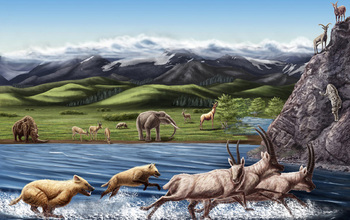 Credit and Larger Version |
For the last 2.5 million years, Earth has experienced millennia-long cold and warm cycles. During cold periods, continental-scale ice sheets have blanketed large tracts of the Northern Hemisphere.
As climate warmed, glaciers receded, leaving Yosemite-like valleys and similar geologic features behind.
The advance and retreat of the ice sheets also had a profound influence on the evolution and geographic distribution of many animals, including those that live in far northern regions.
New results from research conducted in the Himalayan Mountains and published this week in the journal Proceedings of the Royal Society B: Biological Sciences identify a recently discovered three to five million-year-old Tibetan fox, Vulpes qiuzhudingi, as the likely ancestor of the living arctic fox, Vulpes lagopus.
The finding lends support to the idea that the evolution of present-day animals in the Arctic traces back to ancestors that adapted to life in cold regions in the high-altitude Tibetan Plateau.
The paper's lead author is Xiaoming Wang of the Natural History Museum of Los Angeles County. Co-authors are Zhijie Jack Tseng from the University of Southern California, Qiang Li from the Chinese Academy of Sciences, Gary Takeuchi from the Page Museum at the La Brea Tar Pits and Guangpu Xie from the Gansu Provincial Museum.
The scientists, part of a team of geologists and paleontologists led by Wang, uncovered fossil specimens of the Tibetan fox in the Zanda Basin in southern Tibet.
In addition to the fox, the team also discovered extinct species of a wooly rhino (Coelodonta thibetana), three-toed horse (Hipparion), Tibetan bharal (Pseudois, known as blue sheep), chiru (Pantholops, known as Tibetan antelope), snow leopard (Uncia), badger (Meles), and 23 other mammals.
The new fossil assemblage lends credence to a scenario the scientists call the "Out of Tibet" hypothesis.
It argues that some Ice Age megafauna--which in North America include the woolly mammoth, saber-toothed cat and giant sloth--used ancient Tibet as a training ground for developing adaptations that allowed them to cope with a harsh climate.
"The concept 'Out of Tibet' is an exciting insight for the origin of cold-adapted mammals of the Pleistocene," says Rich Lane, program director in the National Science Foundation's (NSF) Division of Earth Sciences, which funded the research.
"It parallels the 'Out of Africa' theory for the evolution of hominids. Together they may be a model for wider application in biological history and geography."
Tibet, Wang says, is a rich but grueling location for paleontological fieldwork.
Fifteen summer field seasons and a great deal of luck have led to his and his colleagues' successes.
Their expeditions involve a one-week journey to Lhasa, then a four-day drive into the remote "layer cake" sediments of the Zanda Basin--a drive made in old-model Land Cruisers known for becoming mired in streambeds.
At the more than 14,000-foot elevation, it's difficult to breathe, water freezes overnight in camps, and the scientists often must walk alone in search of fossils.
They've trained their eyes to search for ancient lake margins, where megafauna are reliably found.
Despite the challenges, Wang says that it's his favorite place to look for fossils.
"It's a pristine environment, the Tibetan people are kind, and in paleontological terms," he says, "it's relatively unexplored."
| -- | Cheryl Dybas, NSF (703) 292-7734 cdybas@nsf.gov |
| -- | Kristin Friedrich, L.A. County Museum of Natural History (213) 763-3532 kfriedri@nhm.org |
Investigators Xiaoming Wang
Related Institutions/Organizations Los Angeles County Museum of Natural History Foundation
Related Programs Sedimentary Geology and Paleobiology Related Awards #0958704 Collaborative Research: Late Cenozoic Vertebrate Paleontology and Paleoenvironments of the Tibetan Plateau (China)

Pliocene Tibetan fox localities (red stars); Ice Age arctic fox (yellow); and today's arctic fox.
Credit and Larger Version
%20reduced_055c9151-ae34-41b9-9e0f-8bdad8076a2f.jpg)
Rich and well-preserved vertebrate fossils were recently discovered in Zanda Basin exposures.
Credit and Larger Version
_r.jpg)
Shown here: fossilized jawbones of the Himalayan fox, closely related to the modern arctic fox.
Credit and Larger Version

The ancestral wooly rhino in the Zanda Basin was well-adapted to cold environments.
Credit and Larger Version

The Kunlun Mountains are the highest site where fossil mammals have been found.
Credit and Larger Versión
the National Science Foundation's (NSF)
Guillermo Gonzalo Sánchez Achutegui
ayabaca@gmail.com
ayabaca@Hotmail.com
ayabaca@yahoo.com
Inscríbete en el Foro del blog y participa : A Vuelo De Un Quinde - El Foro!

No hay comentarios:
Publicar un comentario